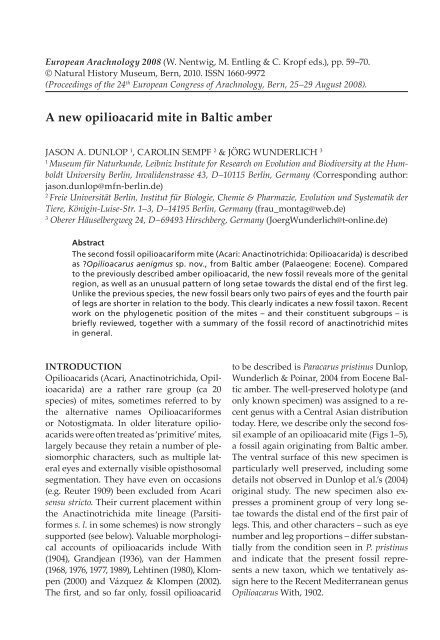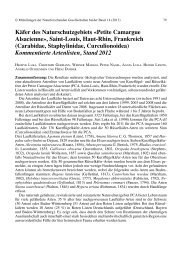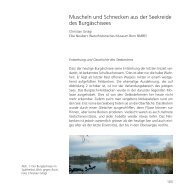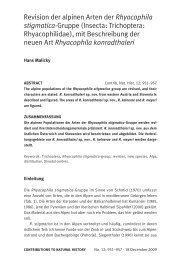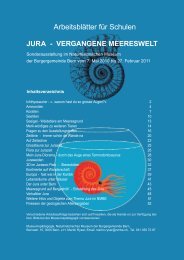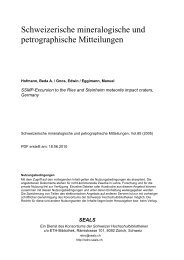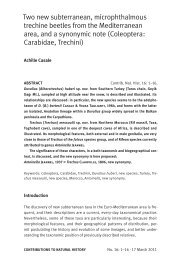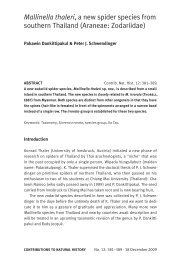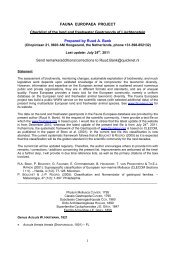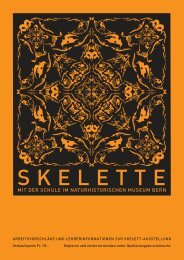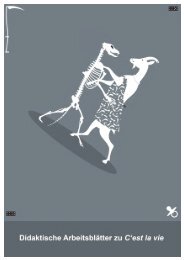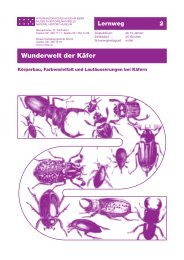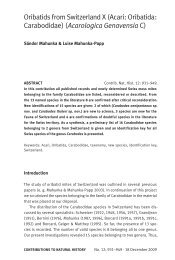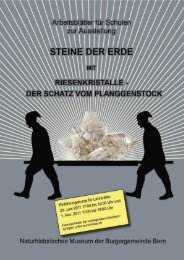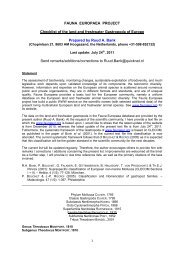Opilioacarus aenigmus Dunlop, Sempf & Wunderlich
Opilioacarus aenigmus Dunlop, Sempf & Wunderlich
Opilioacarus aenigmus Dunlop, Sempf & Wunderlich
Create successful ePaper yourself
Turn your PDF publications into a flip-book with our unique Google optimized e-Paper software.
European Arachnology 2008 (W. Nentwig, M. Entling & C. Kropf eds.), pp. 59–70.<br />
© Natural History Museum, Bern, 2010. ISSN 1660-9972<br />
(Proceedings of the 24 th European Congress of Arachnology, Bern, 25–29 August 2008).<br />
A new opilioacarid mite in Baltic amber<br />
JASON A. DUNLOP 1 , CAROLIN SEMPF 2 & JÖRG WUNDERLICH 3<br />
1 Museum für Naturkunde, Leibniz Institute for Research on Evolution and Biodiversity at the Humboldt<br />
University Berlin, Invalidenstrasse 43, D–10115 Berlin, Germany (Corresponding author:<br />
jason.dunlop@mfn-berlin.de)<br />
2 Freie Universität Berlin, Institut für Biologie, Chemie & Pharmazie, Evolution und Systematik der<br />
Tiere, Königin-Luise-Str. 1–3, D–14195 Berlin, Germany (frau_montag@web.de)<br />
3 Oberer Häuselbergweg 24, D–69493 Hirschberg, Germany (Joerg<strong>Wunderlich</strong>@t-online.de)<br />
Abstract<br />
The second fossil opilioacariform mite (Acari: Anactinotrichida: Opilioacarida) is described<br />
as ?<strong>Opilioacarus</strong> <strong>aenigmus</strong> sp. nov., from Baltic amber (Palaeogene: Eocene). Compared<br />
to the previously described amber opilioacarid, the new fossil reveals more of the genital<br />
region, as well as an unusual pattern of long setae towards the distal end of the first leg.<br />
Unlike the previous species, the new fossil bears only two pairs of eyes and the fourth pair<br />
of legs are shorter in relation to the body. This clearly indicates a new fossil taxon. Recent<br />
work on the phylogenetic position of the mites – and their constituent subgroups – is<br />
briefly reviewed, together with a summary of the fossil record of anactinotrichid mites<br />
in general.<br />
INTRODUCTION<br />
Opilioacarids (Acari, Anactinotrichida, Opilioacarida)<br />
are a rather rare group (ca 20<br />
species) of mites, sometimes referred to by<br />
the alternative names Opilioacariformes<br />
or Notostigmata. In older literature opilioacarids<br />
were often treated as ‘primitive’ mites,<br />
largely because they retain a number of plesiomorphic<br />
characters, such as multiple lateral<br />
eyes and externally visible opisthosomal<br />
segmentation. They have even on occasions<br />
(e.g. Reuter 1909) been excluded from Acari<br />
sensu stricto. Their current placement within<br />
the Anactinotrichida mite lineage (Parsitiformes<br />
s. l. in some schemes) is now strongly<br />
supported (see below). Valuable morphological<br />
accounts of opilioacarids include With<br />
(1904), Grandjean (1936), van der Hammen<br />
(1968, 1976, 1977, 1989), Lehtinen (1980), Klompen<br />
(2000) and Vázquez & Klompen (2002).<br />
The first, and so far only, fossil opilioacarid<br />
to be described is Paracarus pristinus <strong>Dunlop</strong>,<br />
<strong>Wunderlich</strong> & Poinar, 2004 from Eocene Baltic<br />
amber. The well-preserved holotype (and<br />
only known specimen) was assigned to a recent<br />
genus with a Central Asian distribution<br />
today. Here, we describe only the second fossil<br />
example of an opilioacarid mite (Figs 1–5),<br />
a fossil again originating from Baltic amber.<br />
The ventral surface of this new specimen is<br />
particularly well preserved, including some<br />
details not observed in <strong>Dunlop</strong> et al.’s (2004)<br />
original study. The new specimen also expresses<br />
a prominent group of very long setae<br />
towards the distal end of the first pair of<br />
legs. This, and other characters – such as eye<br />
number and leg proportions – differ substantially<br />
from the condition seen in P. pristinus<br />
and indicate that the present fossil represents<br />
a new taxon, which we tentatively assign<br />
here to the Recent Mediterranean genus<br />
<strong>Opilioacarus</strong> With, 1902.
6 0 European Arachnology 2008<br />
MATERIAL AND METHODS<br />
The fossil described here derives from the<br />
<strong>Wunderlich</strong> collection (F1882/BB/AC/CJW)<br />
and will eventually be transferred either to<br />
the Senckenberg Museum (Frankfurt am<br />
Main) or the Görlitz Museum. It was photographed<br />
using a Leica Systems camera arrangement<br />
attached to a stereomicroscope,<br />
which generates a series of images through<br />
the specimen at different focal planes. The<br />
ca 20 individual images per picture were<br />
combined into final composites (Figs 1, 2)<br />
using the software package Auto Montage © .<br />
A Canon Eos Digital Camera attached to a<br />
Nikon compound microscope was used for<br />
close-up work (Fig. 5). The specimen was<br />
drawn by CS using a stereomicroscope with<br />
a camera lucida attachment. (Figs 3–4) Morphological<br />
terminology was adopted from<br />
the literature, principally van der Hammen<br />
(1976), but also Klompen (2000). The precise<br />
locality from which the specimen was<br />
recovered is not recorded, but much of the<br />
recently collected Baltic amber originates<br />
from the Kaliningrad area on the coast of the<br />
Baltic sea. It is generally dated at Palaeogene<br />
(Eocene), with an approximate age of 45–50<br />
Ma.<br />
MORPHOLOGICAL INTERPRETATION<br />
The specimen is a largely complete inclusion,<br />
preserved at the base of a subtriangular<br />
piece of translucent, yellow amber with<br />
maximum dimensions of ca 12 x 6 mm. The<br />
specimen is best seen in ventral view. A hole<br />
in the posterior dorsal part of the body, together<br />
with a thin, white emulsion over the<br />
entire upper body makes interpretation of<br />
the dorsal surface more difficult. Limbs and<br />
mouthparts are preserved in some detail<br />
(see below) and in general the fossil closely<br />
resembles living opilioacarid species. All<br />
measurements are in mm.<br />
Dorsal surface. The mite body is traditionally<br />
divided into a gnathosoma (i.e. the<br />
pedipalps and mouthparts) and the idiosoma<br />
comprising the remainder of the body.<br />
The idiosoma is broadly oval in outline. Dorsally<br />
there is a subtriangular ‘anterior area’<br />
(cf. Klompen 2000), alternatively called the<br />
prodorsum (sensu van der Hammen 1976,<br />
1989) and perhaps equivalent to the carapace<br />
of other arachnids. Due the emulsion film,<br />
details such as setae are largely equivocal<br />
(Fig. 1). However, on the right side two eye<br />
lenses can be resolved (Fig. 3), suggesting<br />
that the animal had two pairs of eyes (see<br />
chap. Systematic Palaeontology). The anterior<br />
area is delimited posteriorly by a transverse<br />
disjugal furrow. Behind this, further<br />
furrows hint at up to four additional, short<br />
dorsal segments on the remainder of the<br />
idiosoma. However, expected details (setae,<br />
lyrifissures, spiracles, etc.) are indistinct due<br />
to the emulsion film and the fact that much<br />
of the posterior part of the dorsal idiosoma<br />
has collapsed to leave a large hole in the dorsal<br />
surface.<br />
Gnathosoma. In ventral view (Figs 2, 4,<br />
5a) the ventral surface (infracapitulum) of<br />
the gnathosoma is quite well preserved and<br />
partly overlain by the sternapophyses (see<br />
below) which cover the expected position of<br />
the subcapitular gutter. Laterally, the dark,<br />
sclerotised rutella insert on this infracapitulum.<br />
As in modern taxa, the rutella are dentate<br />
on their inner (mesal) surface and we<br />
were able to resolve five teeth in total. We<br />
could not identify either With’s organ – expected<br />
immediately mesal of each rutellum<br />
– or the adjacent lateral lips and regard these<br />
as equivocal for the fossil. Between the rutella,<br />
the anterior margin of the infracapitulum<br />
is slightly recurved and presents a series of<br />
quite elongate, anteriorly-projecting setae<br />
(Figs 4–5a). In van der Hammen’s terminology<br />
these probably comprise circumbuccal<br />
and paralabial setae; whereby the rutella and<br />
With’s organ are often interpreted as modified<br />
paralabial setae. Specific patterns of setae<br />
position on the infracapitulum could not<br />
be resolved. The bases of the chelicerae are<br />
hidden in the ventral view, but as in modern<br />
opilioacarids there are three articles, the dis-
tal two forming a small chela. The fixed finger<br />
is slightly dentate, the free (movable) finger<br />
is smooth. The pedipalps are fairly short<br />
and pediform. The proximal articles are<br />
largely concealed above the gnathosoma, but<br />
the terminal tarsus can be seen more clearly.<br />
It is covered distally with fine setae and<br />
bears a pair of very fine claws (the apotele).<br />
Ventral idiosoma. The ventral idiosoma<br />
reveals more detail. At the anterior end, a pair<br />
of slender, elongate sternapophyses project<br />
forwards and underlie the gnathosoma (Figs<br />
2, 4, 5a). Setal patterns on the sternapophysis<br />
can be useful taxonomically, but the presence<br />
of any particular pattern in the fossil is<br />
difficult to resolve. We found evidence for at<br />
least one lateral seta on each sternapophysis;<br />
possibly the latero-ventral, antaxial one<br />
sensu van der Hammen (1989). Flanking the<br />
sternapophyses are the sternal verrucae;<br />
rounded, wart-like valves of uncertain function.<br />
Genital structures are detailed below.<br />
The post-genital ventral idiosoma preserves<br />
few features of interest; only a couple of isolated<br />
setae. A series of eight weakly defined<br />
transverse furrows, which do not extend all<br />
the way across the ventral surface, probably<br />
indicate segment boundaries, but patterns<br />
of lyrifissures (slit sense organs), which can<br />
also indicate segmentation, could not be resolved.<br />
At the posterior end of the idiosoma,<br />
a distinct anal tubercle is present, closely resembling<br />
that figured by, e.g., van der Hammen<br />
(1989, fig. 122). The opilioacarid anal tubercle<br />
is essentially retractable and consists of<br />
a pair of valves, covering a soft, expandable,<br />
membranous region. Compared to illustrations<br />
of extant species the anal tubercle in<br />
the fossil is quite large, is clearly preserved<br />
in its open, expanded state, and we consider<br />
it plausible that the whole structure has been<br />
forced outwards during fossilisation.<br />
Genital region. Behind the sternapophyses,<br />
the pregenital area of the idiosoma (Fig<br />
5a) contains an approximately ‘V’-shaped<br />
depression. A number of setae can be re-<br />
<strong>Dunlop</strong> et al.: Opilioacarid in Baltic amber 61<br />
solved in this area, but a distinct pattern is<br />
absent. The pregenital area is bordered posteriorly<br />
by a small sclerite – segment VII sensu<br />
van der Hammen – which is procurved<br />
anteriorly, but has a more or less straight<br />
posterior margin. Further lineations, or sulci,<br />
within segment VII can also be resolved.<br />
Segment VII is flanked by the genital verrucae,<br />
a prominent pair of raised, wart-like<br />
structures bearing three setae. In juvenile<br />
instars this plate-like structure is absent<br />
(e.g. van der Hammen 1966, fig. 5B), thus we<br />
interpret this fossil as an adult. Determining<br />
gender is more difficult. In some extant<br />
taxa there are differences in the number of<br />
pregenital papilliform setae: typically five<br />
or more in males as compared to two in females.<br />
These pregenital setae should occur<br />
directly in front of segment VIII (van der<br />
Hammen 1966, fig. 5B) and are not the longer<br />
hairs more widely distributed pregenitally<br />
as alluded to above. We were not able to observe<br />
any papilliform pregenital setae in the<br />
fossil. However, we should note Grandjean’s<br />
(1936) observation that females of <strong>Opilioacarus</strong><br />
segmentatus lack pregenital setae altogether;<br />
thus we favour the possibility that<br />
this specimen could be a mature female. Internal<br />
features such as a female ovipositor or<br />
male accessory glands are equivocal.<br />
Legs. The legs are moderately long and<br />
robust (Figs 1–4). Leg I is longest, followed<br />
by leg IV. Legs II and III are shorter, but it<br />
is difficult to obtain an accurate comparative<br />
measure of total leg length due to their<br />
position bent around the body within the<br />
matrix. The pattern of articles (sensu van der<br />
Hammen, 1966) matches that of Recent opilioacarids,<br />
beginning with a coxa and trochanter;<br />
including two trochanters in legs<br />
III and IV. This is followed by the femur, divided<br />
into a basi- and telofemur in leg I, and<br />
the genu (= patella in arachnological terminology)<br />
and tibia; subdivided into a basi- and<br />
telotibia in leg I. The tarsus is divided into a<br />
basitarsus, a telotarsus and, in legs II–IV, additionally<br />
an acrotarsus. The legs end in the
62 European Arachnology 2008<br />
Fig. 1. <strong>Opilioacarus</strong> <strong>aenigmus</strong> n. sp., an opilioacarid<br />
mite from Palaeogene (Eocene) Baltic<br />
amber. Dorsal overview. Scale bar equals 0.5<br />
mm.<br />
pretarsus in the form of a fleshy pulvillus,<br />
plus the apotele consisting of a small pair of<br />
claws or ungues.<br />
The legs are largely covered with distinct<br />
rows of robust, perpendicular, papilliform<br />
setae, but towards their distal ends ordinary<br />
setae (sensu van der Hammen, i.e. unmodified<br />
hairs or setae) come to dominate, especially<br />
on leg IV. These ordinary setae are not<br />
so outstanding and tend to lie flatter against<br />
the article along its length. On the proximal<br />
articles the papilliform setae tend to be clubshaped,<br />
while on more distal podomeres<br />
they are often thinner, more pointed and resemble<br />
the ordinary setae. On the proximal<br />
podomeres of legs II–IV, the papilliform setae<br />
largely occur in four discrete rows – i.e.<br />
dorsal, ventral and two lateral – although<br />
additional rows of shorter papilliform setae<br />
can be seen as in, e.g., the distal half of the<br />
femur of leg IV. This regularity breaks down<br />
towards the distal end. It is also worth noting<br />
that on the dorsal side at least one proximal<br />
article, probably a trochanter of leg 2,<br />
the setae are small and slightly fan-shaped<br />
and may be notched distally (see also illustrations<br />
in van der Hammen’s papers). Leg<br />
I in the fossil is slightly different in that the<br />
papilliform setae are less perpendicular and<br />
are more angled towards the limb articles<br />
and they persist in regular rows at least up<br />
to the end of the tibia.<br />
Of particular note here are additional<br />
long, slender, presumably sensory, setae<br />
originating from the distal end of the tibia<br />
and the proximal end of the basitarsus of leg<br />
1 (Figs 1, 3). Up to twelve individual hairs,<br />
at least as long as the basitarsus, can be resolved<br />
(Fig 5b); some of which actually recurve<br />
backwards from their insertion point.<br />
We have been unable to find a matching description<br />
for such setae in the opilioacarid<br />
literature and this character does not seem<br />
to be known from modern species (Hans<br />
Klompen, pers. comm. 2008). The possibility<br />
that these hairs could be fungal in nature –<br />
and thus not part of the animal – was considered,<br />
but examination courtesy of Alexander<br />
Schmitt (pers. comm. 2008) who has<br />
much experience with amber microorganisms<br />
(e.g. Schmitt et al. 2007) did not support<br />
a fungal origin. The hairs seem to originate<br />
directly from the body and to be preserved<br />
in an identical manner to the mite’s other setae.<br />
The long hairs thus appear to be genuine<br />
and a convincing diagnostic character<br />
for the fossil species.<br />
PALAEOECOLOGY<br />
In recent years a number of amber arachnids<br />
have been published which imply the presence<br />
of dry, well-lit habitats within the original<br />
Baltic amber forest environment. These<br />
potential indicator taxa include the opilioacarids,<br />
like the one described here, camel<br />
spiders (Solifugae) and certain spiders (Ara-
neae) for example in the family Plectreuridae<br />
(<strong>Wunderlich</strong> 2004). All of these taxa are<br />
very rare in amber and typically known<br />
only from isolated specimens. Their modern<br />
relatives have a tendency to be found in dry<br />
habitats; i.e. not deep in forests. Assuming<br />
that the amber species had a similar ecology<br />
to their recent counterparts, one could<br />
conceive of them inhabiting ‘dry islands’<br />
within the larger Eocene forest – similar environments<br />
being known even in the modern<br />
Amazon rainforests. According to Bachofen-Echt<br />
(1949: 33–35) certain plants have<br />
also been recorded in Baltic amber, which<br />
today show a preference for dry and sunny<br />
habitats: namely members of the Ericaceae,<br />
Euphorbiaceae, Santalaceae, Thymeliaceae<br />
and Urticaceae. Conceivably the arachnids<br />
mentioned above may have undergone some<br />
sort of passive transport – the mechanism of<br />
which remains unclear – to reach the sapsecreting<br />
trees. This might explain the extreme<br />
rarity of these animals.<br />
SYSTEMATIC PALAEONTOLOGY<br />
Acari Nitzsch, 1818<br />
Comments. Mites can be broadly divided into<br />
two major lineages; see e.g. Alberti (2006)<br />
for details and a recent review. The anactinotrichids<br />
(Parasitiformes sensu lato in some<br />
schemes) include opilioacarids (see below),<br />
gamasids, holothyrids and ticks. The actinotrichids<br />
(Acariformes in some schemes)<br />
include the remaining mite groups: such as<br />
velvet mites, water mites, gall mites, oribatids<br />
and the astigmatids such as fur, food<br />
or dust mites, etc. The question of whether<br />
mites form a single, monophyletic lineage<br />
– as favoured by, e.g., Lindquist (1984) and<br />
assumed in most cladistic studies of arachnid<br />
relationships – has recently come back<br />
into focus. <strong>Dunlop</strong> & Alberti (2008) offered<br />
a summary of developments in this field.<br />
Interestingly, Shultz (2007) recovered mites<br />
as paraphyletic with respect to the speciespoor<br />
arachnid order Ricinulei, at least under<br />
<strong>Dunlop</strong> et al.: Opilioacarid in Baltic amber 6 3<br />
Fig. 2. <strong>Opilioacarus</strong> <strong>aenigmus</strong> n. sp., an opilioacarid<br />
mite from Palaeogene (Eocene) Baltic<br />
amber. Ventral overview. Scale bar equals 0.5<br />
mm.<br />
some parameters of analysis. This is the first<br />
time that an explicit test of parsimony has<br />
favoured diphyletic mite origins. Klompen<br />
et al.’s (2007) molecular results found weak<br />
support for a monophyletic Acari and further<br />
studies in this direction with a wider<br />
taxon sampling would be welcome. Key to<br />
resolving this monophyly question are further<br />
integrative approaches to mites and<br />
non-mite arachnids. An almost independent<br />
literature has developed in both camps, often<br />
with inconsistent terminologies for probably<br />
homologous structures which mask potentially<br />
synapomorphic features. Indeed,<br />
despite decades of morphological study,<br />
<strong>Dunlop</strong> & Alberti (2008: table 1) could identify<br />
surprisingly few unique and unequivocal<br />
characters which could be used to support a
6 4 European Arachnology 2008<br />
Fig. 3. Camera lucida drawing of the specimen<br />
shown in Fig. 1. Scale bar equals 0.5 mm.<br />
particular arachnid order being sister-group<br />
of either all mites, or of one of their two major<br />
lineages.<br />
Anactinotrichida Grandjean in van der<br />
Hammen, 1961<br />
Remarks. Historically, opilioacarids have<br />
been treated as non-mites, ‘primitive’ mites<br />
(see above), or as Grandjean’s (1936) “acarien<br />
synthétique”; the latter view finding reflection<br />
in the recognition of three lineages of<br />
equal rank in combinations such as Opilioacarida,<br />
Anactinotrichida and Actinotrichida<br />
(cf. Harvey 2002). More recently, there<br />
has been fairly unanimous cladistic support<br />
for grouping opilioacarids within Anactinotrichida<br />
(Murrell et al. 2005; Klompen et al.<br />
2007) and lists of explicit characters shared<br />
by opilioacarids and other members of this<br />
group, can be found in, e.g., Alberti (2006)<br />
and <strong>Dunlop</strong> & Alberti (2008) and references<br />
therein. The sister-group of Opilioacarida is<br />
in dispute. The more traditional view (e.g.<br />
Lindquist 1984) – also recovered from the<br />
molecular data of Klompen et al. (2007) –<br />
places opilioacarids as sister-group of the<br />
Parasitifomes sensu stricto, i.e. Holothyrida,<br />
Gamasida (= Mesostigmata) and Ixodida<br />
(ticks). By contrast Murrell et al. (2005), also<br />
using molecular data, did not recover parasitiforms<br />
s. s. as monophyletic; instead resolving<br />
opilioacarids as sister-group to holothyrids<br />
and ticks only, with gamasids now<br />
forming the outgroup. Further discussion<br />
can be found in these publications.<br />
Opilioacarida With, 1902<br />
Family Opilioacaridae Vitzthum, 1931<br />
Genus ?<strong>Opilioacarus</strong> With, 1902<br />
Comments. Only a single opilioacarid family<br />
is currently accepted. Harvey (1996, fig. 2)<br />
recognised nine genera plus two undescribed<br />
Australian ones. Of these, our new<br />
fossil can be excluded from Paracarus Chamberlin<br />
& Mulaik, 1942 from Central Asia and<br />
Siamacarus Leclerc, 1989 from Thailand, since<br />
both genera are characterised by three pairs<br />
of eyes. The new fossil has only two pairs.<br />
Significantly, this also shows that the new<br />
fossil is not conspecific with the previous<br />
record from Baltic amber, Paracarus pristinus,<br />
which also has three pairs of eyes (<strong>Dunlop</strong><br />
et al. 2004, fig. 2a). A further notable difference<br />
is in the length of the fourth leg. In P.<br />
pristinus this is distinctly elongate – about 2.1<br />
times the length of the body and similar in<br />
length to the first pair of legs – while in the<br />
new fossil the fourth leg is about 1.6 times<br />
body length and a little shorter than the first<br />
leg. This relatively long fourth leg was noted<br />
by van der Hammen (1968, p. 67) as diagnostic<br />
for Paracarus.<br />
Of the remaining seven genera, Harvey<br />
(1996) recognised a clade containing Vanderhammenacarus<br />
Leclerc, 1989 from Thailand,<br />
Salfacarus van der Hammen, 1977 from<br />
southern Africa and Madagascar and Panchetes<br />
Naudo, 1963 from West Africa, plus the
undescribed Australian forms. These were<br />
defined by the putative apomorphy of dorsal<br />
setae on segments XV–XVII. This character<br />
cannot be tested here adequately due to<br />
the broken and emulsion-covered posterior<br />
dorsal surface. However, a second feature<br />
was also mentioned for these taxa (Harvey<br />
1996, p. 157), namely the presence of two or<br />
more ventral setae on segment XVIII; i.e. the<br />
segment preceding the anal tubercle. While<br />
body hairs are generally not easy to resolve<br />
in our new fossil we found no evidence for<br />
hairs in front of the anal tubercle (Figs. 2, 4)<br />
and thus tentatively use this feature to exclude<br />
the three genera listed above.<br />
Four genera remain under consideration.<br />
Phalangiacarus Coineau & van der Hammen,<br />
1979 from West Africa was defined by a<br />
very long and pale (depigmented) first pair<br />
of legs, ca 2.8 times as long as the body. The<br />
first leg of our new fossil is only about 1.8<br />
times body length and shows no evidence of<br />
depigmentation. For this reason we exclude<br />
it from Phalangiacarus. We were only able to<br />
discern at most five teeth in the rutellum<br />
which, according to van der Hammen (1969,<br />
p. 125), would exclude Adenacarus van der<br />
Hammen, 1966 from Yemen which has six.<br />
However, Lehtinin (1980) cautioned that the<br />
armature of the rutellum may only be of value<br />
for defining species. The two remaining<br />
genera, Neocarus Chamberlin & Mulaik, 1942<br />
from America and <strong>Opilioacarus</strong> With, 1902<br />
from the Mediterranean region, have historically<br />
proved problematic and were treated<br />
by some authors (see especially van der<br />
Hammen 1966, 1989) as synonyms. Authors<br />
such as Lehtinen (1980) recognised characters<br />
such as a strong basal tooth on the rutellum<br />
and two setae on the sternapophyses as<br />
potentially diagnostic for Neocarus. Yet when<br />
compared to illustrations in the original description<br />
of the <strong>Opilioacarus</strong> type species, O.<br />
segmentatus With 1902 (cf. pl. 4, fig. 4), the<br />
basal tooth of the rutellum appears quite<br />
large too, while Grandjean (1936, fig. 3B) figured<br />
two hairs on the sternapophysis of the<br />
same <strong>Opilioacarus</strong> species!<br />
<strong>Dunlop</strong> et al.: Opilioacarid in Baltic amber 6 5<br />
Fig. 4. Camera lucida drawing of the specimen<br />
shown in Fig. 2. Scale bar equals 0.5 mm.<br />
In summary, we favour affinities with<br />
<strong>Opilioacarus</strong> based on a combination of<br />
morphology (see above) and geographical affinities<br />
with the Mediterranean. However, we<br />
concede that we have mostly had to exclude<br />
taxa based on negative characters and that<br />
the features available in the fossil are not as<br />
extensive as those used in the taxonomy of<br />
living opilioacarids and thus do not permit<br />
an unequivocal assignment. The long setae<br />
on the first leg of the fossil (see above) appear<br />
to be a unique feature compared to living<br />
opilioacarids. Conceivably, the new fossil<br />
could be raised to a new genus, but we<br />
prefer to adopt a cautious approach given<br />
that there are unresolved questions about<br />
the taxonomy of the living species as per<br />
the <strong>Opilioacarus</strong>/Neocarus problem alluded to<br />
above.<br />
?<strong>Opilioacarus</strong> <strong>aenigmus</strong> sp. nov. (Figs 1–5)<br />
Material. <strong>Wunderlich</strong> collection no. F1882/<br />
BB/AC/CJW. Baltic amber, exact locality not<br />
recorded, but probably from the vicinity of
6 6 European Arachnology 2008<br />
Fig. 5. a. Close-up of the gnathosomal and<br />
genital region. b. Close-up of the putative<br />
long setae on the tibia and basitarsus of the<br />
first leg. Such setae are not known from any<br />
living species.<br />
Kaliningrad, Baltic coast of Russia. Palaeogene<br />
(Eocene).<br />
Diagnosis. Fossil <strong>Opilioacarus</strong> uniquely<br />
with ca 12 elongate hairs on the distal tibia<br />
and proximal basitarsus of leg I.<br />
Description. Body oval, total length (without<br />
gnathosoma) 1.6, maximum width 0.85.<br />
Anterior area (prodorsum) of idiosoma 0.52<br />
long, bearing two eye lenses on right side.<br />
Corresponding eye position on left side obscured.<br />
Prodorsum demarcated by transverse<br />
groove and followed by four further<br />
transverse grooves demarcating at least four<br />
short, length ca 0.1, segments. Spiracular<br />
openings here and remainder of dorsal idiosoma<br />
equivocal. Gnathosoma compact, includes<br />
chelicerae formed from three articles.<br />
Distal articles chelate; fixed finger dentate,<br />
free finger smooth. Infracapitulum with<br />
semicircle of fine, forward-projecting setae<br />
at its recurved anterior margin. Margin<br />
flanked laterally by rutella. Each rutellum<br />
dentate, with five teeth. With’s organ and lateral<br />
lips equivocal and further gnathosomal<br />
details obscure. Pedipalps pediform, distally<br />
setose, with fine, hair-like claws. Sternapophyses<br />
project together in parallel beneath<br />
the gnathosoma, length 0.37, flanked by<br />
small, rounded (diameter 0.03) paired sternal<br />
verrucae. Pregenital area with sparse setae;<br />
no explicitly pregenital setae observed.<br />
Segment VII small, procurved, sclerotised;<br />
flanked by rounded paired genital verrucae<br />
(diameter 0.09), bearing 3 setae. Postgenital<br />
region of idiosoma largely featureless, but<br />
up to eight furrows hint at segmentation.<br />
Article lengths of leg I: coxa 0.12, trochanter<br />
0.4, basifemur 0.29, telofemur 0.28,<br />
genu 0.54, tibia 0.7, basitarsus 0.25, telotarsus<br />
0.33. Article lengths of leg II: proximal<br />
articles equivocal, basitarsus 0.31, telotarsus<br />
0.16, acrotarsus 0.12. Lengths of leg III: coxa<br />
0.06, trochanter 1 0.17, trochanter 2, 0.10, femur<br />
and genu equivocal, tibia 0.20, basitarsus<br />
0.20, telotarsus 0.16, acrotarsus 0.11. Article<br />
lengths of leg IV: coxa 0.1, first trochanter<br />
0.32, second trochanter 0.17, femur 0.45, genu<br />
0.3, tibia 0.65, basitarsus 0.5, telotarsus 0.17,<br />
acrotarsus 0.22. All legs end in pulvillus<br />
(pretarsus) and paired claws (ungues).<br />
DISCUSSION<br />
Mites actually have a richer fossil record<br />
than might be expected, but there are important<br />
and significant differences between the<br />
two main groups. Actinotrichids potentially<br />
go back as far as the Early Ordovician (ca<br />
480 Ma) (Bernini et al. 2002) and they are unequivocally<br />
present by the Early Devonian<br />
(ca 410 Ma). Their fossil record is quite good<br />
compared to other that of other arachnids<br />
and second only in species number to spiders;<br />
particularly in terms of oribatids from<br />
amber and as subfossils assignable to modern<br />
species from Holocene peat deposits. 292
fossil actinotrichid species (including Recent<br />
forms found as subfossils) have been recorded<br />
(<strong>Dunlop</strong> et al. 2010). By contrast, there are<br />
– including our new find – only fourteen fossil<br />
species of anactinotrichids (Table 1) and<br />
their record goes back no further than the<br />
Cretaceous (e.g. Poinar & Buckley 2008). Fossil<br />
anactinotrichids now include two opilioacarids,<br />
four gamasids, no holothyrids and<br />
eight ticks (both hard and soft). The rather<br />
young and markedly less diverse anactinotrichid<br />
fossil fauna is probably a sampling<br />
artefact and may also reflect the fact that<br />
relatively little effort has been devoted to the<br />
study of non-oribatid mites in amber in gen-<br />
<strong>Dunlop</strong> et al.: Opilioacarid in Baltic amber 67<br />
TAXON AGE LOCALITY LITERATURE<br />
Opilioacarida<br />
Paracarus pristinus Eocene Baltic amber <strong>Dunlop</strong> et al. (2004)<br />
?<strong>Opilioacarus</strong> <strong>aenigmus</strong> Eocene Baltic amber this study<br />
Gamasida<br />
Sejus bdelloides Eocene Baltic amber Koch & Berendt (1854)<br />
*Aclerogamasus stenocornis Eocene Baltic amber Witaliński (2000)<br />
Dendrolaelaps fossilis Miocene Chiapas (Mexican) amber Hirschman (1971)<br />
Paleozercon cavernicolus Miocene New Mexico Cave Blaszak et al. (1995)<br />
Holothyrida<br />
no fossil record<br />
Ixodida<br />
Compluriscutula vetulum Cretaceous Myanmar amber Poinar & Buckley (2008)<br />
Cornupalpatum burmanicum Cretaceous Myanmar amber Poinar & Brown (2003)<br />
Carios jerseyi Cretaceous New Jersey amber Klompen & Grimaldi (2001)<br />
Ixodes succineus Eocene Baltic amber Weidner (1964),<br />
Weitschat (2004)<br />
Ixodes tertiarius Oligocene Wyoming, USA Scudder (1885)<br />
Ornithodoros antiquus Miocene Dominican amber Poinar (1995)<br />
**Amblyomma near argentinae Miocene Dominican amber Lane & Poinar (1986)<br />
**Dermacentor near reticulatus Pliocene auditory canal of a rhino Schille (1916)<br />
Table 1 Summary of fossil anactinotrichids described in the literature, arranged by suborder and<br />
then by stratigraphy (oldest records first).<br />
*Joel Hallan’s online mite catalogue flagged two further Aclerogamasus species from Romania as fossils, but<br />
when checked against the original citation (Juvara-Balş 1977) these are in fact Recent species<br />
described from caves.<br />
**Recent species: described as “A. near testudinus”; a species which has subsequently been treated<br />
as a synonym of A. argentinae (cf. Camicas et al. 1998, p. 103).<br />
eral. Nevertheless, gamasids are an extremely<br />
diverse and abundant group in modern<br />
soil ecosystems and the fact that only four<br />
have been formally identified – and only as<br />
far back as the Eocene – remains puzzling.<br />
ACKNOWLEDGEMENTS<br />
We thank Alexander Schmitt (Göttingen)<br />
for advice on fungi in amber and assistance<br />
with Fig. 5 and Hans Klompen (Columbus,<br />
OH) and Mark Judson (Paris) for valuable<br />
comments.
6 8 European Arachnology 2008<br />
REFERENCES<br />
Alberti, G. 2006. On some fundamental characteristics<br />
in acarine morphology. Atti<br />
della Accademia Nazionale Italiana di Entomologia.<br />
Rendiconti LIII-2005: 315–360.<br />
Bachofen-Echt, A. 1949. Der Bernstein und seine<br />
Einschlüsse. [Reprinted in 1996 by Publishing<br />
House Jörg <strong>Wunderlich</strong>. Straubenhardt,<br />
Germany.]<br />
Bernini, F., Carnevale, G., Bagnoli, G. &<br />
Stouge, S. 2002. An early Ordovician<br />
mite (Acari: Oribatida) from the island of<br />
Öland, Sweden. In: Bernini, F., Nannelli,<br />
R., Nuzzaci, G., Lilo, E. de (eds): Acarid<br />
Phylogeny and Evolution: Adaption in Mites<br />
and Ticks, pp. 45–47, Kluwer Accademic<br />
Publishers, Dordrecht.<br />
Błaszak, J., Cokendolpher, J.C. & Polyak, V.J.<br />
1995. Paleozercon cavernicolous, a new genus<br />
and new species of fossil mite from a<br />
cave in the southwestern U.S.A. (Acari,<br />
Gamasida: Zerconidae). International Journal<br />
of Acarology 21: 253–259.<br />
Camicas, J.-L., Hervy, J.-P., Adam, F., Morel,<br />
P.-C. 1998. Les Tiques du monde. Nomenclature,<br />
stades décrits, hôtes, répartition. Institut<br />
Français de Recherche Scientifique pour le<br />
Développement en Coopération, Paris.<br />
Chamberlin, R.V. & Mulaik, S. 1942. On a<br />
new family in the Notostigmata. Proceedings<br />
of the Biological Society of Washington<br />
55: 125–32.<br />
<strong>Dunlop</strong>, J.A. & Alberti, G. 2008. The affinities<br />
of mites and ticks: a review. Journal<br />
of Zoological Systematics and Evolutionary<br />
Research 46: 1–18.<br />
<strong>Dunlop</strong>, J.A., <strong>Wunderlich</strong>, J. & Poinar jr., G.O.<br />
2004. The first fossil opilioacariform mite<br />
(Acari: Opilioacariformes) and the first<br />
Baltic amber camel spider (Solifugae).<br />
Transactions of the Royal Society of Edinburgh:<br />
Earth Sciences 94: 261–273.<br />
<strong>Dunlop</strong>, J.A., Penney, D. & Jekel, D. 2010. A<br />
summary list of fossil spiders and their<br />
relatives. In Platnick, N. I. (ed.) The world<br />
spider catalog, version 11.0 American Museum<br />
of Natural History, online at http://<br />
research.amnh.org/entomology/spiders/<br />
catalog/index.html<br />
Grandjean, F. 1936. Un acarien synthétique:<br />
<strong>Opilioacarus</strong> segmentatus With. Bulletin de<br />
la Société d’Histoire Naturelle de l’Afrique<br />
du Nord 27: 413–444.<br />
Hammen, L. van der 1961. Description of<br />
Holothyrus grandjeani nov. spec., and notes<br />
on the classification of the mites. Nova<br />
Guinea, Zoology 9: 173–194.<br />
Hammen, L. van der 1966. Studies on Opilioacarida<br />
(Arachnida) I. Description of <strong>Opilioacarus</strong><br />
texanus (Chemberlin & Mulaik)<br />
and revised classification of the genera.<br />
Zoologische Verhandelingen 86: 1–80.<br />
Hammen, L. van der 1968. Studies on Opilioacarida<br />
(Arachnida) II. Redescription of<br />
Paracarus hexophthalmus (Redikorzev). Zoologische<br />
Mededelingen 43: 57–76.<br />
Hammen, L. van der 1976. Glossaire de la terminologie<br />
acrologique. Vol. 2. Opilioacarida.<br />
Dr. W. Junk bv Publishers, The Hague.<br />
Hammen, L. van der 1977. Studies on Opilioacarida<br />
(Arachnidea) IV. The genera Panchaetes<br />
Naudo and Salfacarus gen. nov. Zoologische<br />
Mededelingen 54: 43–78.<br />
Hammen, L. van der 1989. An introduction<br />
to comparative arachnology. SPB Academic<br />
Publishing bv, The Hague.<br />
Harvey, M. 2002. The neglected cousins:<br />
what do we know about the smaller<br />
arachnid orders. Journal of Arachnology<br />
30: 357–372.<br />
Hirschmann, W. 1971. A fossil mite of the<br />
genus Dendrolaelaps (Acarina, Mesostigmata,<br />
Digamasellidae) found in amber<br />
from Chiapas, Mexico. University of California<br />
Publications in Entomology 63: 69–70.<br />
Juvara-Balş, I. 1977. Quelques remarques sur<br />
les Aclerogamasus de Roumanie, A. bicalliger<br />
Athias et A. motasi n. sp. (Acarina: Gamasida:<br />
Parasitidae). Travaux de l’Institut<br />
de Spéologie “Émile Racovitza” 16: 37–45.<br />
Klompen, H. 2000. Prelarva and larva of<br />
<strong>Opilioacarus</strong> (Neocarus) texanus (Chamberlin<br />
and Mulaik) (Acari: Opilioacarida)<br />
with notes on the patterns of setae and<br />
lyrifissures. Journal of Natural History 34:<br />
1977–1992.
Klompen, H. & Grimaldi, D. 2001. First<br />
Mesozoic record of a parasitiform mite:<br />
a larval argasid tick in Cretaceous amber<br />
(Acari: Ixodida: Argasidae). Annals of the<br />
Entomological Society of America 94: 10–15.<br />
Klompen, H., Lekveishvili, M. & Black IV,<br />
W.C. 2007. Phylogeny of parasitiform<br />
mites (Acari) based on rRNA. Molecular<br />
Phylogenetics and Evolution 43: 936–951.<br />
Koch, C.L. & Berendt, G.C. 1854. Die im<br />
Bernstein befindlichen Myriapoden,<br />
Arachniden und Apteren der Vorwelt.<br />
In: Berendt, G.C., Die im Bernstein befindlichen<br />
organischen Reste der Vorwelt. 1. Berlin,<br />
Nicolai.<br />
Lane, R.S. & Poinar, G.O. 1986. First fossil<br />
tick (Acari: Ixodidae) in New World amber.<br />
International Journal of Acarology 12:<br />
75–78.<br />
Leclerc, P. 1989. Considérations paléobiogéographiques<br />
a propos la découverte<br />
en Thailande d’Opilioacariens nouveaux<br />
(Acari – Notostigmata). Compte<br />
Rendu des Séances, Société de Biogéographie,<br />
Paris 65: 162–74.<br />
Lehtinen, P.T. 1980. A new species of Opilioacarida<br />
(Arachnida) from Venezuela.<br />
Acta biologica Venezuelica 10: 205–214.<br />
Lindquist, E.E. 1984. Current theories on<br />
the evolution of major groups of Acari<br />
and on their relationships with other<br />
groups of Arachnida with consequent<br />
implications for their classification. In:<br />
Griffiths, D.A. & Bowman, C.E. (eds),<br />
Acarology, Vol. 1., pp. 28–62, Ellis Horwood<br />
Ltd., Chichester.<br />
Murrell, A., Dobson, S.J., Walter, D.E., Campbell,<br />
N.J.H., Shao, R. & Barker, S.C. 2005.<br />
Relationships among the three major lineages<br />
of the Acari (Arthropoda: Arachnida)<br />
inferred from small subunit rRNA:<br />
paraphyly of the Parasitiformes with respect<br />
to the Opilioacarifomes and relative<br />
rates of nucleotide substitution. Invertebrate<br />
Systematics 19: 383–389.<br />
Naudo, M.H. 1963. Acariens Notostigmata de<br />
l‛Angola. Publicações Culturais da Companhia<br />
de Diamantes de Angola, Lisboa 63: 13–24.<br />
<strong>Dunlop</strong> et al.: Opilioacarid in Baltic amber 6 9<br />
Nitzsch, C.L. 1818. In: Ersch, J.S. & Gruber,<br />
J.G., Allgemeine Encyclopaedie der Wissenschaften<br />
und Künste 1, Leipzig.<br />
Poinar, G.O. 1985. First fossil soft tick, Ornithodoros<br />
antiquus n. sp. (Acari: Argasidae)<br />
in Dominican amber with evidence of<br />
their mammalian host. Experientia Basel 51:<br />
384–387.<br />
Poinar, G.O. & Brown, A. 2003. A new genus<br />
of hard ticks in Cretaceous Burmese amber<br />
(Acari: Ixodida: Ixodidae). Systematic<br />
Parasitology 54: 199–205.<br />
Poinar, G.O. & Buckley, R. 2008. Compluriscutula<br />
vetulum (Acari: Ixodida: Ixodidae), a<br />
new genus and species of hard tick from<br />
Lower Cretaceous Burmese amber. Proceedings<br />
of the Entomological Society of<br />
Washington 110: 445–450.<br />
Reuter, E. 1909. Zur Morphologie undOntogenie der Acariden mit besonderer Berücksichtigung<br />
von Pediculopis graminum.<br />
Acta Societatis Scientiarum Fennica 36:<br />
1–288.<br />
Schille, F. 1916. Entomologie aus der Mammut-<br />
und Rhinoceros-Zeit Galiziens. Entomologische<br />
Zeitschrift 30: 42–43.<br />
Schmidt, A.R., Dörfelt, H. & Perrichot, V.<br />
2007. Carnivorous fungi from Cretaceous<br />
amber. Science 318: 1743.<br />
Schultz, J.W. 2007. A phylogenetic analysis<br />
of the arachnid orders based on morphological<br />
characters. Zoological Journal of the<br />
Linnean Society 150: 221–265 .<br />
Scudder, S.H. 1885. Arachnoidea. Spinnen.<br />
Skorpione. In: Zittel, K.A. (ed.), Handbuch<br />
der Palaeontologie. I. Abteilung. Palaeozoologie.<br />
II. Band. Mollusca und Arthropoda, pp.<br />
732–746. Verlag von R. Oldenbourg, München<br />
& Leipzig.<br />
Vázquez, M.M. & Klompen, H. 2002. The<br />
family Opilioacaridae (Acari: Parasitiformes)<br />
in North and Central America,<br />
with descriptions of four new species.<br />
Acarologia 42: 299–322.<br />
Vitzthum, H. Graf 1931. 9: Ordnung der Arachnida:<br />
Acari=Milben. In: Kükenthal, W.<br />
(ed.), Handbuch der Zoologie, Vol. III, 2. (3),<br />
pp. 1–160, Walter de Gruyter & Co., Berlin.
7 0 European Arachnology 2008<br />
Weidner, H. 1964. Eine Zecke, Ixodes succineus<br />
sp. n. im Baltischen Bernstein. Veröffentlichungen<br />
aus dem Überseemuseum Bremen<br />
3: 143–151.<br />
Weitschat, W. 2004. Zecken im Bernsteinwald<br />
– wahre Raritäten. ImpfDialog 2004<br />
(1): 11–12.<br />
Witaliński, W. 2000. Aclerogamasus stenocornis<br />
sp. n., a fossil mite from the Baltic<br />
amber (Acari: Gamasida: Parasitidae).<br />
Genus 11: 619–626.<br />
With, C.J. 1902. A new acaride <strong>Opilioacarus</strong><br />
segmentatus. Comptes Rendus du Congrès des<br />
Naturalistes et Médicins du Nord 20: 4–5.<br />
<strong>Wunderlich</strong>, J. 2004. Fossil spiders (Araneae)<br />
of the superfamily Dysderoidea in Baltic<br />
and Dominican amber, with revised family<br />
diagnoses. In: <strong>Wunderlich</strong>, J. (ed.), Beiträge<br />
zur Araneologie 3: 633–746.


